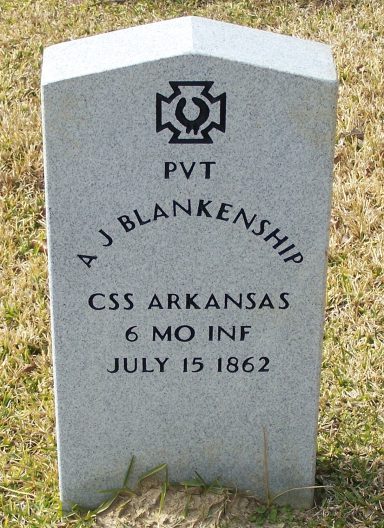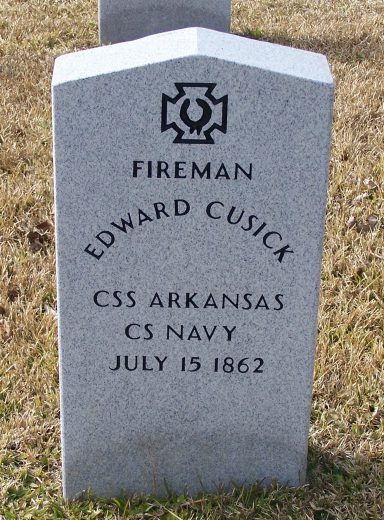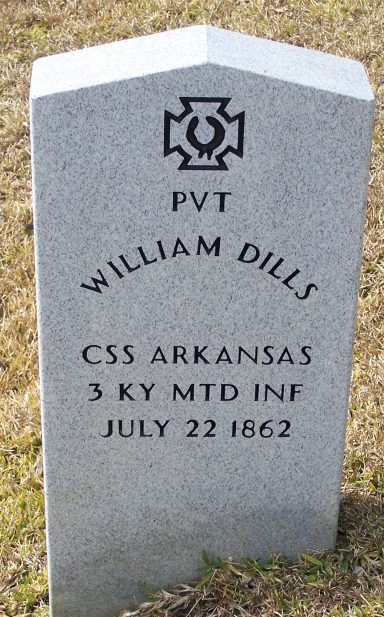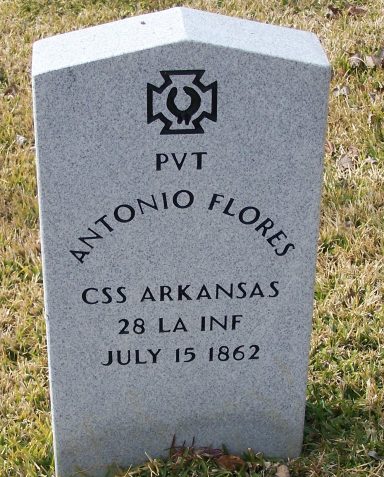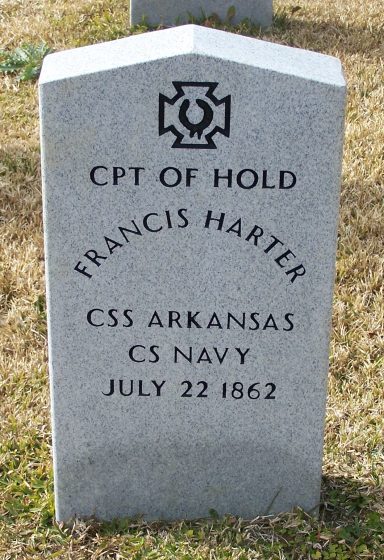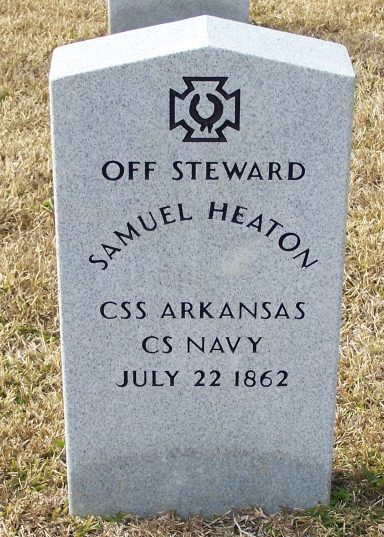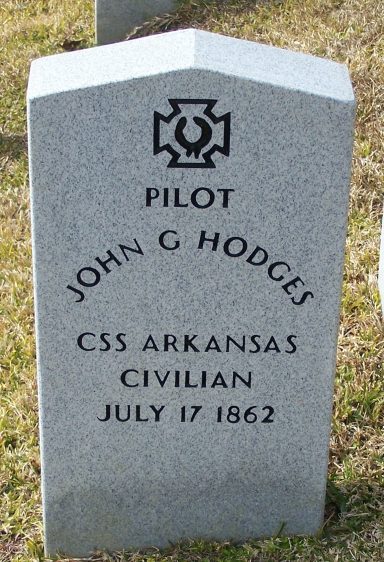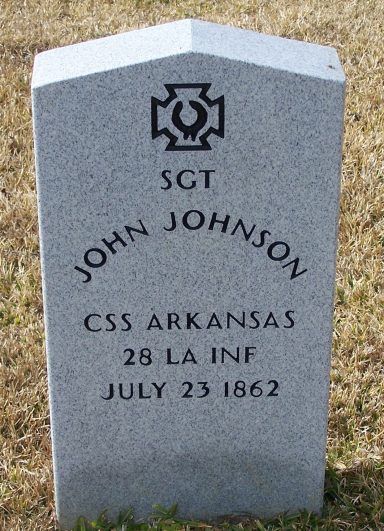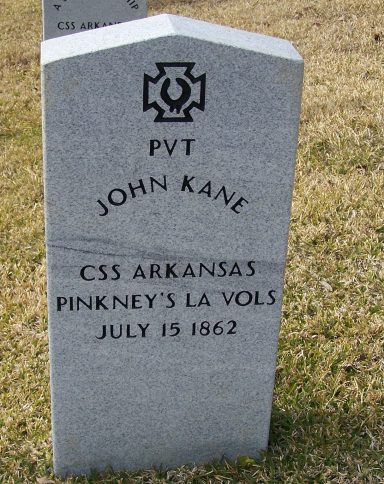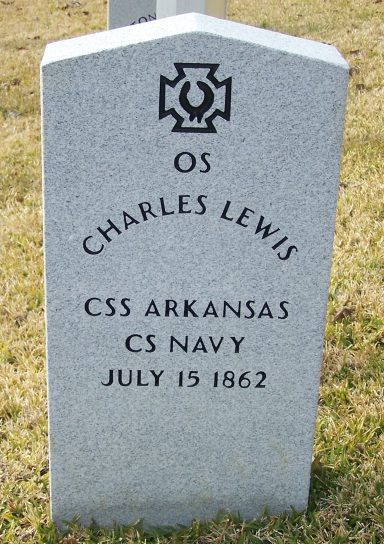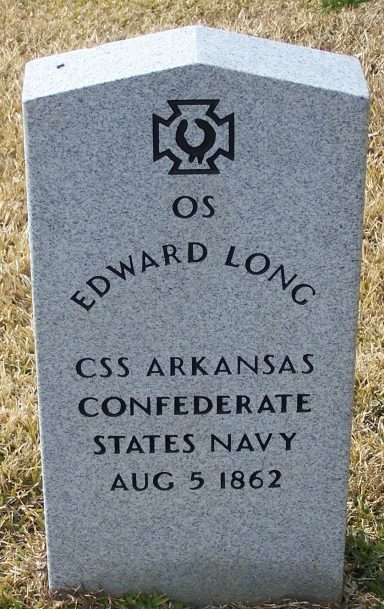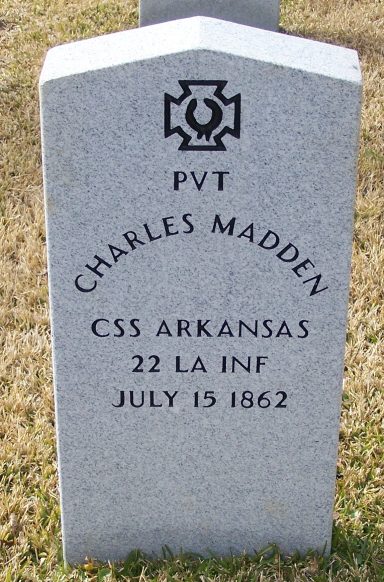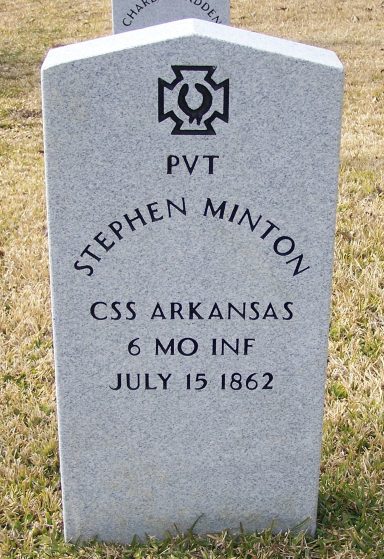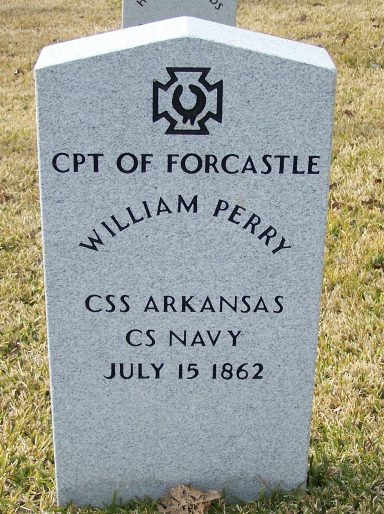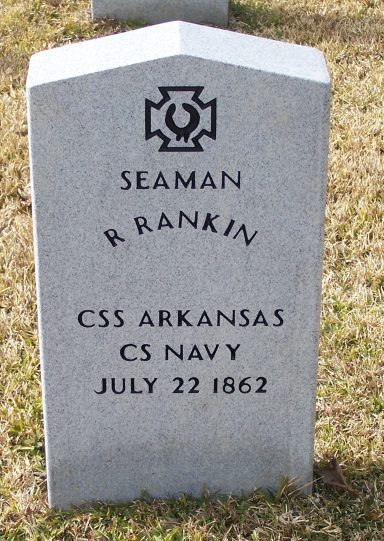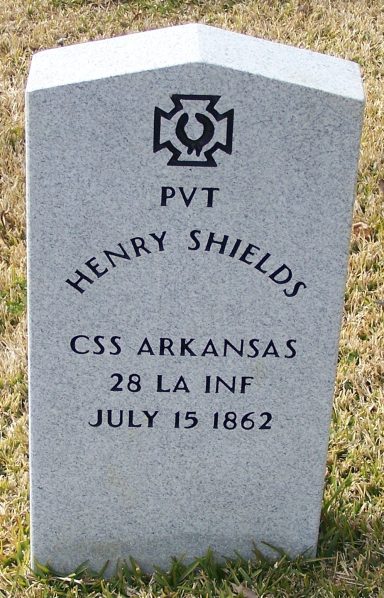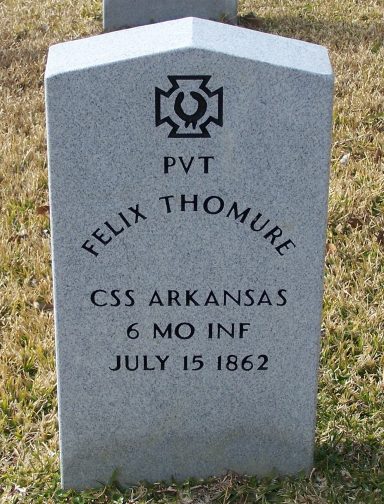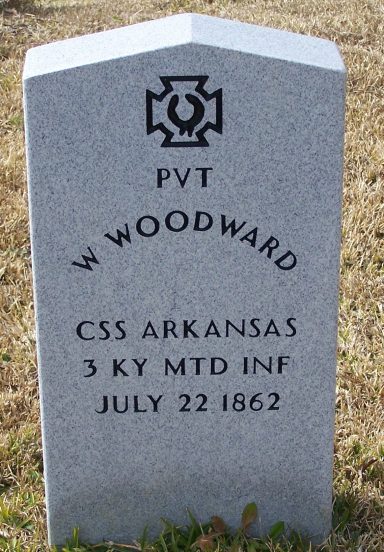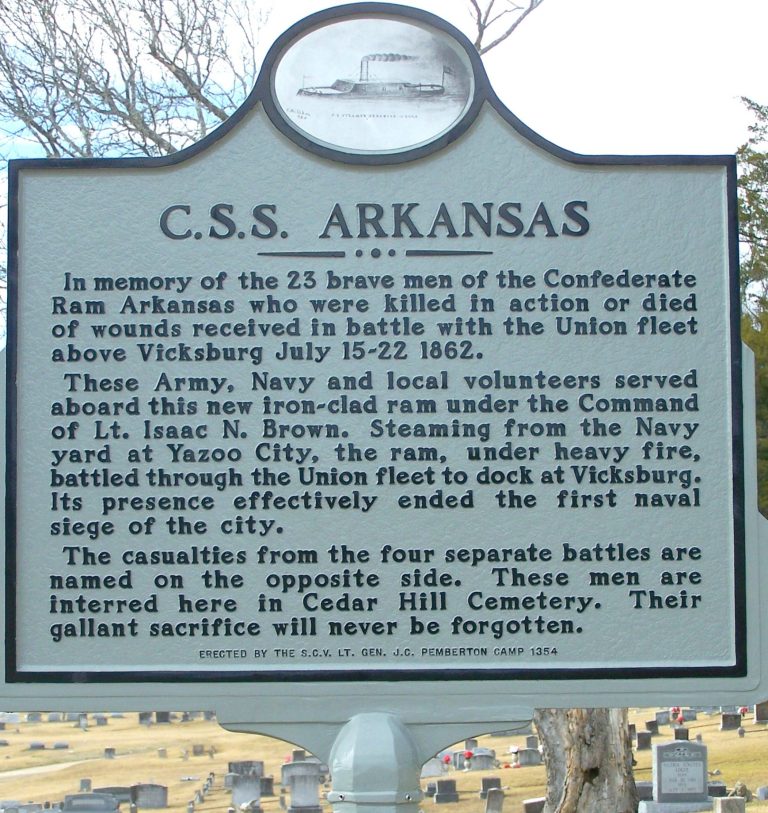
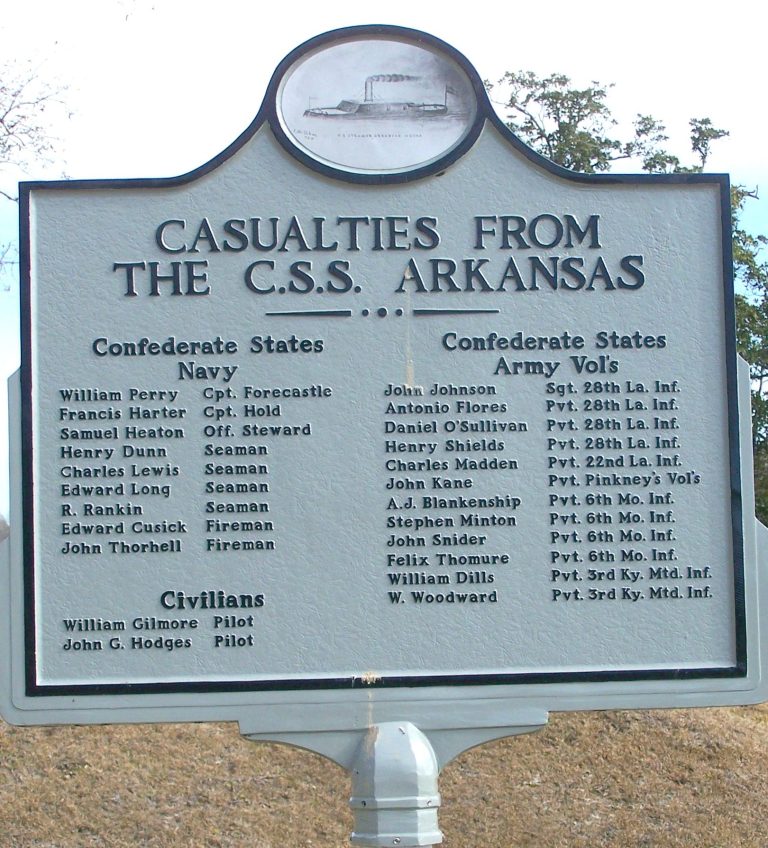
Story of the CSS Arkansas
On 15 Jul 1862, a naval event occurred on the Mississippi River at Vicksburg, Mississippi, that in history books rarely gets the notice it deserves.
The heroine, if we may, of this historic event is the Confederate States Steam Ram Arkansas, or CSS Ram Arkansas, a spanking new ironclad with a crew that was a mix of experienced naval men, citizens, and Confederate infantry and artillery soldiers. The crew had been begged for and borrowed from the Navy and Army and surrounding population, and only a handful had been in any watercraft larger than a rowboat.
Vicksburg was besieged in June 1862 by two Federal fleets, that of Flag Officer C. H. Davis' and that of Flag Officer Farragut. The two fleets had joined up at Vicksburg to demand that the city surrender or be attacked. The citizens of the unarmed city refused the threat and Gen. Martin L. Smith passed that message along so adamantly in writing that Gen. Farragut wrote back to his headquarters that the people of Vicksburg did not know how nor did they want to learn how to surrender. On 28 Jun 1862, the two fleets began shelling the city. Onboard cannon and mortars on the mortar barges sent shells bursting in the sky over Vicksburg, like fireworks, day and night, and whistling into the city. Gen. Smith and the citizens stood fast.
Foster Lightcap (left) was one of the citizens killed in the bombardment 23 Jun 1862. He was "A well beloved citizen of Vicksburg." Five days later, 28 Jun, Patience Gamble was hit by a shell fragment as she was walking home.
Rumor was that a Confederate ironclad was being built at a makeshift shipyard located up the Yazoo River. Many scoffed at that, aware that the Confederates had no shipbuilding facilities, industries, or resources in the swampy, wooded area. The Union General David Dixon Porter later wrote that, "they did not believe the Confederates had sufficient resources to build a powerful vessel in such an out-of-the-way place."
But the rumor persisted and, in mid July, three Federal ships -- the Carondelet, Tyler, and Queen of the West -- were sent up the Yazoo to reconnoiter and were caught surprised when they saw the new ram, the Arkansas, heading their way. Click to enlarge painting. A battle ensued during which the Arkansas' crew learned of the fickleness of the boat's two engines when one quit and the other caused the ram to draw a full circle in the Yazoo. The Confederate gunners took advantage of the changes of scenery and took shots at the enemy's boats, sending them racing fast as possible back to their fleet, the rumored ironclad now real and alive and on their tails, despite her speed being hindered by the perforations in her funnel from the enemy shot.
The men in the Federal fleet, hearing the ship cannon booming, watched while their Carondelet and Tyler hurried toward them, the sailors waving and yelling warnings. Then the CSS Ram Arkansas suddenly appeared, as if spit from the mouth of the Yazoo River, sliding into the current of the Mississippi, twelve miles above Vicksburg and only four miles above the ships of Farragut and Davis.
Her appearance on the river surprised the Federal fleet who half-believed that the Arkansas was simply a rumor. Now here she was, chasing two Federal boats she had surprised as they reconnoitered the Yazoo. Her guns were firing as she rounded into the Mississippi, bursting upon the fleet of the unsuspecting and unprepared Federals lining the two banks of the Mississippi. The crews scrambled to their places on their boats and ships, but they had been caught with their boilers down and thus lacked power and maneuverability. They were sitting ducks. Still, they prepared their guns and turned them on the Arkansas, each ship releasing its barrage as the Arkansas passed by them, returning their own furious fire. Flames and thunder leaped from the ten barrels of the Arkansas' guns. The Federal guns, however, inflicted minimal damage thanks to the iron sides of the Arkansas. When the ram's shells found the enemy's engine rooms, the steam boilers exploded, sending many scalded enemy sailors into the river.
The Arkansas' stack (or smokestack) suffered further and it was increasingly difficult for the firemen to build up steam in the boiler, causing the ram to lose precious speed. The current naturally aided her, as it swept toward Vicksburg. (This stack is off the Virginia but is similar that of the Arkansas'. Note the shot and shell damage.)
The battle went on for two hours. The cheering inhabitants of Vicksburg lined the bluffs of the town, and Major Generals John C. Breckenridge, Earl Van Dorn, and Stephen D. Lee climbed the Court House clock tower for a better view. On the river north of Vicksburg, they could see only roiling clouds of smoke. The sounds of the cannons were constant and deafening. All ashore waited to see if the Arkansas would emerge from the thick haze.
Yes! There she was, passing now beneath the protection of Vicksburg's batteries. The few Federal ships that attempted pursuit were met with the fire of the defensive batteries, sending them turning back to the safety of their own fleets.
The Federals were furious with themselves for being caught unprepared. A fuming Farragut wrote to his superiors that he was completely "humiliated." The Arkansas had bested them and, worse, had escaped. They swore to sink her at all costs and save face.
The Arkansas tied up at the Vicksburg landing amid cheers and admiring crowds. Visitors hurried aboard to congratulate the Captain. Swaddling the still-hot guns, the smoke of the battle hung thickly in the air, parting only to reveal the sights of the blood and brains and body parts scattered throughout the gun casemate and piled against its interior sides. The acrid, sickening smell of the carnage followed the visitors as the specter of death walked them off the boat.
When darkness fell that day, several Federal ships came down the river and passed the Arkansas, still tied up at the waterfront, and attacked the ram with cannon as they passed. However, because of the fading light and the clay-color of the siding the boat was hard to see, only its firing, fiery cannon giving away her presence in the twilight.
The next morning, 16 Jul, Capt. Brown turned in a casualty list of 12 soldiers killed, 15 wounded and 3 badly wounded.
For two weeks, the Federal shelling of the city continued, the cannon booming from the ships and the mortars' shells arching in colors from their boats under the river's edge where the Confederate batteries on the bluffs could not reach them. Across the river, on the De Soto, there was the unseen and ever-present danger of the enemy snipers. Sometimes their fire seemed so close that it was impossible to work on the repair Arkansas or even approach it from town without inviting death.
On 28 July, the Arkansas still remained, tied up at Vicksburg, a constant concern to the Federals. Sometimes she would sally out into the river, perhaps to test her moody and undependable engines and to make it clear that she was still there and had no intention of abandoning the city.
Other attempts were made to sink the Arkansas, but they were unsuccessful, though there were Confederate casualties. On 22 July, the Federal boats Essex and Queen of the West, returning to their fleet south of Vicksburg attempted in passing to ram the Arkansas and sink it, but failed in that, but again caused casualties. The river currents carried them on south toward Farragut's fleet, where they remained. On 28 July, Farragut's fleet sailed back south, and Davis took his fleet back north, leaving Vicksburg fairly at peace.
It must have dawned upon some Federal leaders that the Arkansas had not only successfully and heroically passed through the Federal fleet and put herself between them and Vicksburg, but that she had uselessly tied up the two fleets, Davis' northern fleet and Farragut's southern fleet, there at Vicksburg. And not just tied up the fleets, but also the thousand plus soldiers brought with them on transports to Vicksburg, only to lose hundreds to sicknesses and the unbearable Southern heat. (D. M. Scales later wrote a letter to his father saying that after the Federals left, he and others had explored the Federal camps on DeSoto Island and had seen approximately 600 graves.)
The actions of the CSS Ram Arkansas saved Vicksburg from the Federal fleet and showed the value of a navy in war. And even though the South was lacking in the resources of the industrial North, she had managed, with Southern determination, ingenuity, imagination, and brains, to build from her own backwoods a most formidable fighting machine.
Known crew of the CSS Arkansas
Navy - Civilian Position
1 Addison. W.J. Surg.
2 Anderson,James Coxswan
3 Bacon, Edward Cpts. Clerk
4 Bacot,Richard Midship.
5 Baldwin,Robert T. Asst. Surg.
6 Banks,Robert B. M.D.
7 Barbot,Alphonso Lieut.
8 Beecher, Arnold Ord. Seaman
9 Brady,James Pilot
10 Brown,Eugene 3 Asst. Engr.
11 Brown, Isaac " Capt." Lieut. Cmdr.
12 Caulfield,Peter Coal Hvr.
13 Cenas,Hilary 2nd Lieut.
14 City,George Cheif Engr.
15 Clifford,Daniel Seaman
16 Cooke,Henry Midship.
17 Covert,Ellison 2 Asst.Engr.
18 Curtis Qtr. Mstr.
19 Cusick,Edward Fireman
20 Davis,Nicholas Seaman
21 Doland,James 3rd Asst.Engr.
22 Duer Asst. Engr.
23 Dunn,Henry Seaman
24 Dupuy,John 3 Asst. Engr.
25 Eaton Qtr.Mstr.
26 Fautleroy, William Cheif Engr.
27 Gettis,James 3 Asst.Engr.
28 Gift,George Lieut.
29 Gilmore,Willaim Pilot
30 Grimball,John Lieut.
31 Hardee,Charles Off. Stew.
32 Harter,Francis Cpt. Hold
33 Heaton,Samuel Off. Stew.
34 Henderson,C.R. Asst. Surg.
35 Hodges,John Pilot
36 Jack,E.A. 3 Asst.Engr.
37 Jackson,William 3 Asst.Engr.
38 Kelly,John Seaman
39 Lang,Ed Seaman
40 Lewis,Charles Ord. Seaman
41 May,T.L. Fireman
42 McCalla,Robert Seaman
43 Meyer, Midship.
44 Millikin,Sam Actg. Mstr.
45 Montgomery,James Pilot
46 Morfit,Charles Asst.Surg.
47 Norton,Patrick Landsman
48 Perry,William Cpt. Forcastle
49 Phillips,John Actg. Mstr.
50 Pledge,John Ord. Seaman
51 Rankin,R Seaman
52 Read,Charles Lieut.
53 Scales,Dabney Midship.
54 Shacklett,James Pilot
55 Stevens,Henry Lieut.
56 Talbot,Daniel Midship.
57 Taylor,Richard Asst. Pay.
58 Thorhell,John Fireman
59 Travers,Thomas Actg. Gunr.
60 Tyler,Clarence Midship.
61 Unknown Chief Engr.
62 Washington,H.W.M. Surg.
63 Wharton,Arthur Lieut.
64 Wilson,John Mstr.Mate
65 Wilson ( Joseph ) Pay. Clerk
Missouri.
----- 1st Mo. Inf. -----
1 Abshear, Eli
2 Brookman, William
3 Butler, John
4 Carmoody, James
5 Cavett, George
6 Cooligan, Henry
7 Garrison, William H.
8 Garrison, William, J.
9 Haney, Joel
10 Holland, James
11 McDonough, Peter
12 McGovern, John
13 Miller, John
14 Oldham, Joseph
15 O'Neil, Michael
16 Pollard, George Pilot
17 Reynolds, James
18 Riley, John
19 Shay, Michael
20 Smith, George
21 Snyder, Joseph
22 Thompson, Alex.
23 Tucker, Franklin Pilot
24 Welsh, Thomas
------- 6th Mo. Inf.---------
1 Albert,Alexander
2 Anderson,Charles
3 Bauman,Jerimiah
4 Birchett,J.W.
5 Blankenship,A.J.
6 Calvert,T.C.
7 Carter,John
8 Crawford,William
9 Crouch,William
10 Dale,Asbury
11 Dale,William
12 Davidson,John
13 Dennis,Lawrence
14 Dowdy,Josiah
15 Evans,David
16 Fitzpatrick,Charles
17 Ford,Green B.
18 Galvin,John
19 Girard,Louis
20 Govero,Donner
21 Hale,Jerome
22 Hamilton,C.H.
23 Hamilton,J.D.
24 Harris,S.S.
25 Hempstead,Sam
26 Hollowman,A.A.
27 King,Henry
28 Labrier,Xavier
29 Ladd,John
30 LaRose, Augustus
31 LaRose, Israel
32 LaRose,J.B.
33 Martin, John L.
34 McDonald,R
35 McDowell,James
36 McLure,David
37 Miles,Nicholas
38 Minton,Smith
39 Minton,Stephen
40 Moore, John A.
41 Ohlhausen,James
42 Paul,C.D.
43 Pipkin, W.M.
44 Portman,Joseph
45 Riddell,J.R.
46 Robbins,John
47 Sevier,Thomas
48 Snyder, John
49 Summers,William
50 Thomure,Felix
51 Thomure,Leon
52 Treadway,J.W.
53 Wagner,W.C.
54 Watson,Berry
Louisiana.
---- Pinkneys Volunteers ----
1 Kane, John
---- 1st Heavy Arty -----
1 Alexander, J
2 Alexander,William
3 Cranmer,Nodiah
4 Lynch,Thomas
5 Lynch, William
6 Murray,John
7 Sullivan, John
8 Thompson,George
9 Western, William
----- 17th Inf. ---------
1 Clark, Thomas
2 Dixon, James
3 Donnelley,Henry
4 Enwright,Maurice
5 Gerald, J.D.F.
6 Johnson,John
7 Kirkpatrick, J.E.S.
----- 22/23 Con. Inf. -----
1 Cole,Henry
2 Edley,Thomas
3 Madden,Charles
-----28th Inf.----------
1 Ballard,W.J.
2 Behm,August
3 Birmingham,W.H.
4 Box,James
5 Brown,John
6 Burns, J.J.
7 Craig,Francis
8 Donnelley,Michael
9 Erwin,G.W.
10 Florez,Antonio
11 Hardcastle,T.C.
12 Helmig,William
13 Helmock,Louis
14 Jones,Phillip
15 Mannervitz,Louis
16 Martin,Aleck
17 Martinez,Bernard
18 Meyer,William
19 O'Sullivan,Daniel
20 Schmidt,Felix
21 Scott,Richard
22 Settigg,Charles
23 Shields,Henry
24 Talbot,James
25 Walsh,Ed
26 Williams,Charles
27 Wolf,Gotleib
28 Woodruff,N.M.
Kentucky.
----- Cobbs Co. ------
1 Black,Daniel
2 Brindley,James
3 Cobb, Robert H.
4 Leonard,John
5 Mathews,Robert
6 Moore, Benjamin
7 Thornton,Charles
8 Watts,Thomas
-----3rd Mtd. Inf. -----
1 Dills, William
2 Ross, Edward B.
3 Woodard, W
-----6th Mtd. Inf. --------
1 Allen,Caleb
Tennessee.___
----- 1st Heavy Arty ------
1 Parks,William P.
Mississippi.
----- Hudsons Battery -----
1 Hoole,James
----- Cowans Battery ------
1 Flatau, Louis
----- Bucks Cav. --------
1. Breckenridge, C.R.
Unknown Unit Volunteer's
1 Evans,Henry
2 Hill, J.R.
Construction Crew
1 Hicks, W.A. CSN Lieut.
2 Jackson,John Carpenter
3 McFarland, John Civil Engr.
4 Weldon, Thomas Civil Engr.
Lt. W.A. Hicks, was killed during construction.
